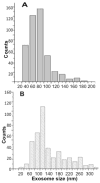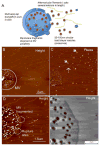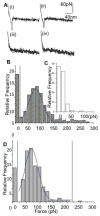Quantitative nanostructural and single-molecule force spectroscopy biomolecular analysis of human-saliva-derived exosomes
- PMID: 22017459
- PMCID: PMC3235036
- DOI: 10.1021/la2038763
Quantitative nanostructural and single-molecule force spectroscopy biomolecular analysis of human-saliva-derived exosomes
Abstract
Exosomes are naturally occurring nanoparticles with unique structure, surface biochemistry, and mechanical characteristics. These distinct nanometer-sized bioparticles are secreted from the surfaces of oral epithelial cells into saliva and are of interest as oral-cancer biomarkers. We use high- resolution AFM to show single-vesicle quantitative differences between exosomes derived from normal and oral cancer patient's saliva. Compared to normal exosomes (circular, 67.4 ± 2.9 nm), our findings indicate that cancer exosome populations are significantly increased in saliva and display irregular morphologies, increased vesicle size (98.3 ± 4.6 nm), and higher intervesicular aggregation. At the single-vesicle level, cancer exosomes exhibit significantly (P < 0.05) increased CD63 surface densities. To our knowledge, it represents the first report detecting single-exosome surface protein variations. Additionally, high-resolution AFM imaging of cancer saliva samples revealed discrete multivesicular bodies with intraluminal exosomes enclosed. We discuss the use of quantitative, nanoscale ultrastructural and surface biomolecular analysis of saliva exosomes at single-vesicle- and single-protein-level sensitivities as a potentially new oral cancer diagnostic.
© 2011 American Chemical Society
Figures




References
-
- Almeida JP, Chen AL, Foster A, Drezek R. Nanomedicine (Lond) 2011;6(5):815–35. - PubMed
-
- Al-Nedawi K, Meehan B, Rak J. Cell Cycle. 2009;8(13):2014–8. - PubMed
-
- Koga K, Matsumoto K, Akiyoshi T, Kubo M, Yamanaka N, Tasaki A, Nakashima H, Nakamura M, Kuroki S, Tanaka M, Katano M. Anticancer Res. 2005;25(6A):3703–7. - PubMed
-
- Psyrri A, DiMaio D. Nat Clin Pract Oncol. 2008;5(1):24–31. - PubMed
Publication types
MeSH terms
Grants and funding
LinkOut - more resources
Full Text Sources
Other Literature Sources
Miscellaneous

